
Learn about the importance of eating whole foods as opposed to eating processed foods. [1:00]
- Subject:
- Health and Physical Education
- Material Type:
- Audio/Video
- Provider:
- PBS LearningMedia
- Date Added:
- 12/01/2022

Learn about the importance of eating whole foods as opposed to eating processed foods. [1:00]
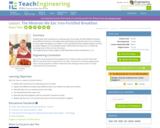
In this lesson, students will learn that minerals are a necessary part of our diet. They will learn that different minerals have different functions in the body. More specifically, they will discover that iron is necessary to carry oxygen around the body. In the associated activity, students will design a process that removes the most iron from the cereal.

In this Fuel It! video, Ella and Sela team up to create a delicious and healthy variation of the fruit roll up. The pair spread peanut butter on a tortilla and then top it with apples and sharp cheese to create their Fruit Fold-Up. [3:39]

Brady and Noel work together to create gluten free optional Fruit Muffins in this Fuel It! video. The two use healthy ingredients such as brown rice flour and a variety of fruits to create an alternative to the sugary muffin often found in stores. [4:16]

In this Fuel It! video, Becky demonstrates how to create a healthy version of the much-loved snack, trail mix. Using a variety of dry ingredients, such as raisins, peanuts and banana chips, she creates her own Fruit Trail Mix. [3:21]
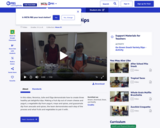
In this video, Veronica, Julie and Olga demonstrate how to create three healthy yet delightful dips. [1:53]
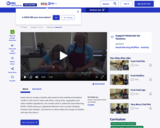
Learn how to create a healthy alternative to the traditional breakfast muffin in this Fuel It! video with Mara. Using fruits, vegetables and other healthy ingredients, she creates what is called the Good Morning Muffin. [2:10]

In this Fuel It! video, Thomas revs up for the day by making a Good Stuff Shake. With the use of a wide variety of healthy ingredients, such as carrots, grapes, juice and broccoli, Thomas is able to make the perfect afterschool snack. [4:07]

When a food company is offering a new product, changing ingredients, or researching potential products, it is important for the company to know what the consumer reaction is likely to be of the product. Become food panelists to determine if you can taste the difference in two fruit smoothie products and determine if there is a statistical significance in the data collected from the taste test. This unit features 3 lessons and 6 files. Lessons are aligned to NGSS.
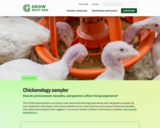
This STEM-based poultry curriculum uses immersive learning experiences and real genetic samples for your students to dive deep in the future evolution of our food. See how environment influences heredity, and explore the evidence that suggests T. rex as our modern chicken’s and turkey’s ancestor. This unit features 4 lessons and 10 files. Lessons are aligned to NGSS.

Take on multiple roles within an aquaculture farm including set-up and maintenance of tanks, test water quality, investigate possible feed sources and monitor fish health and growth. This unit features 5 lessons and 9 files. Lessons are aligned to NGSS.

Current trends in consumer behavior show that people want to eat healthier and are looking for simple ways to transform their diets. High oleic soybean oil features lower saturated fat while maintaining 0 grams of trans fat, which may lower cholesterol and support heart health. This unit features 2 lessons and 6 files. Lessons are aligned to NGSS.

Have you ever heard students utter the words “What’s the point? What does this have to do with anything?” This lesson is an engaging 3 part challenge in which students apply their knowledge to help solve a real-life problem, global hunger. Students are “hired” by the World Soy Foundation to create an infographic advertisement about soy products that could help end world hunger. Students will conduct research on aspects of world hunger, and several soy-based options to address them. Using their research, they will construct an infographic. This unit features 3 lessons and 9 files. Lessons are aligned to NGSS.

Have you ever looked on a food label and seen soy products on it, even though it wasn’t made from soybeans? This unit explores the various uses of soy in foods and how soy can be used to accomplish various functions in food science by asking students to measure the nutrient content of various foods, determine the function of soy in foods, and shows how fermentation of soy can be used to make different foods. This unit features 4 lessons and 17 files. Lessons are aligned to NGSS.
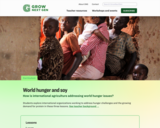
Students explore international organizations working to address hunger challenges and the growing demand for protein in these three lessons. This unit features 3 lessons and 6 files. Lessons are aligned to NGSS.

The Healthy Kids Project uses song, movement, and animation in ten engaging lessons that support healthy choices and attitudes--teaching not only successful actions, but also successful strategies. It's a turnkey kit for teachers to impart critical life lessons about health, without taking time away from core subjects.

Learn why eating fruits and vegetables is a healthy choice. [0:59]
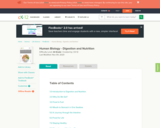
The Digestion and Nutrition Student Edition book is one of ten volumes making up the Human Biology curriculum, an interdisciplinary and inquiry-based approach to the study of life science.

PBS: In Defense of Food Curriculum. It is designed to help adolescents develop something valuable:practical tools for healthier eating. It helps students learn why it is important to eat healthfully, investigate how food companies influence their food choices, and create action plans for changing their eating habits.

A video introducing the two different processes of metabolism: catabolism and anabolism. Video gives lots of example to explain that catabolism is a process of breaking down and anabolism rebuilds matter. [10:06]
Khan Academy learning modules include a Community space where users can ask questions and seek help from community members. Educators should consult with their Technology administrators to determine the use of Khan Academy learning modules in their classroom. Please review materials from external sites before sharing with students.